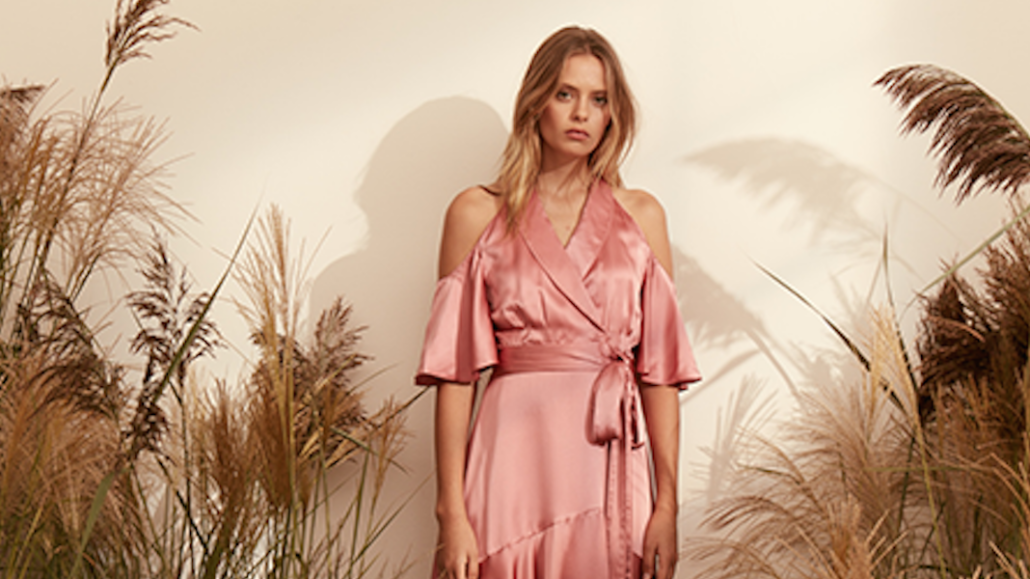Save 50% on a 3-month Digiday+ membership. Ends Dec 5.
Inside Amur, a new sustainable line inspired by a career in ‘harmful’ fashion

Sofia Shannon, creative director of Amur, didn’t set out to create a run-of-the-mill sustainable fashion company, but rather a brand with a collection of one-of-a-kind pieces.
Though Amur — which stands for A Mindful Use of Resources — launched its first collection in spring, it’s already found its way into the closets of celebrities and fashion influencers, including Vanessa Hudgens and Olivia Palermo. This is in part thanks to Shannon’s flare for design, cultivated during previous design roles at Ronny Kobo and Cynthia Rowley, and it’s also tied to her use of natural or recycled fibers throughout her collections.
The New York–based company sells online and in select boutiques to a wide array of shoppers; according to Shannon, its shoppers’ age range spans from 18 to 65. This points to the resonance of Amur, which is determined to prove that sustainable pieces can be as stylish as any.
We caught up with Shannon to learn about what went into creating Amur and to get her perspective on the state of the fashion industry.
On the inspiration for Amur:
I learned a lot about the fashion industry and how harmful it is for the environment when I first started working in fashion. As a designer, I didn’t want to ignore the fact that every choice I made [affected] the environment; I wanted my work to connect with my values. As a consumer, I started buying things differently, everything from beauty products to what I ate. I had a higher consciousness of every decision I made and its consequences, both on the environment and my body.
How Amur sets itself apart from other sustainable fashion companies:
It’s fun and feminine. It’s novel. Each piece is special and something you wear when you’re going out somewhere; it’s not an organic cotton T-shirt. Support for Amur has been very organic. I’m thrilled to see girls with such an influence wearing the brand — women that are such icons. It’s amazing. Each one of them wears it in their own special style.
Ad position: web_incontent_pos1
On identifying factories that produce sustainably:
We did this in two ways: by reaching out to mills that were already on this journey of sustainability, and by reaching out to regular mills and convincing them this is what they should be doing. We connected them with, say, a recycled yarn supplier, and we created a chain of suppliers to create a particular fabric. We did a lot of begging and convincing people to sign on, and ultimately, we came up with some great fabrics. As a result, mills can offer the same service to other designers and, hopefully, it will create a snowball effect.
Why Amur cares so much about sourcing:
Our focus is on the materials; my design process begins there, as opposed to doing a sketch first and then finding materials. We work specifically within three categories — natural fibers, cellulosic and regenerated fibers — and those materials serve as the starting point for every piece.
On competing with fast fashion:
I can’t compete with fast fashion, and I don’t want to. I want to create unique pieces that last a long time. People are seeing the value in that. Eventually, more will see that clothes from fast-fashion chains don’t last.
On her ultimate goal for the company:
Fashion is a huge industry and the second-highest polluting industry. Positive changes we make in this industry can result in positive changes on a larger scale. At the end of the day, what we choose to buy is a personal decision. We like to share our story. Some people are going to relate to it, and some won’t.
More in Marketing

Ulta, Best Buy and Adidas dominate AI holiday shopping mentions
The brands that are seeing the biggest boost from this shift in consumer behavior are some of the biggest retailers.

U.K. retailer Boots leads brand efforts to invest in ad creative’s data layer
For media dollars to make an impact, brands need ad creative that actually hits. More CMOs are investing in pre- and post-flight measurement.

‘AI is permeating everything we do’: How Guitar Center developed 2 AI tools this year
This summer, the company launched a chatbot called Rig Advisor to help customers find the right instruments and products.
Ad position: web_bfu









